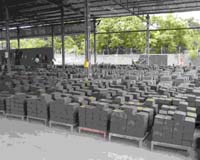 |
Bonn, Germany (SPX) Apr 13, 2010 Two trends are emerging for future renewable electricity. In the first, local solar, wind or biomass plants will produce more energy for small communities or single homes. In the second, large amounts of electricity will be generated by solar power stations in desert areas or extensive offshore wind farms, and delivered over long distances to densely populated areas. But how can electrical power be delivered over long distances without large losses? The solution to this problem is direct current. When electrical power at voltages from 100,000 to 1,000,000 volts is routed through high-voltage direct current (HVDC) transmission cables, energy losses are significantly reduced. Conventional AC or three-phase cables lose around 15 percent of transmitted power over a distance of 1000 kilometres, while HDVC cables lose only 3 to 4 percent of their load. Since DC cables can be insulated better than AC cables, HVDC is also ideal for short-distance delivery over undersea as well as underground cables.
Good experiences with direct current In China, a 800,000 volt cable will be commissioned this year to bridge the 1418 kilometres between the provinces of Guangdong and Yunnan. In Europe there are no overground HVDC cables, but the NorNed undersea cable between Norway and Holland and the Baltic Cable between Norway and Germany both employ HVDC technology. Three large companies share the growing HVDC market: Siemens, ABB and Areva. When the desert-based energy project, DESERTEC - which DLR researchers are playing a major role in designing and planning - is built, there will be more contracts for them. In the future, an HVDC cable, more than 3000-kilometres long, could run from solar power plants in the Sahara, under the Mediterranean, to Central Europe. In addition, Europe could be supplied with electricity from wind farms off the Scandinavian or North African coasts through HVDC cables.
Careful grid planning
Share This Article With Planet Earth
Related Links DLR Powering The World in the 21st Century at Energy-Daily.com
 Bangladesh adopts green brick making
Bangladesh adopts green brick makingDhaka, Bangladesh (UPI) Apr 6, 2010 In an effort to reduce greenhouse gases, Bangladesh has adopted smokeless brick-making technology introduced by the U.N. Development Program. The UNDP will contribute $25 million over the next five years for the new program, which replaces methods used for more than 150 years. Bangladesh's brick industry has grown approximately 5.3 percent during the last decade and is likely to ... read more |
|
| The content herein, unless otherwise known to be public domain, are Copyright 1995-2010 - SpaceDaily. AFP and UPI Wire Stories are copyright Agence France-Presse and United Press International. ESA Portal Reports are copyright European Space Agency. All NASA sourced material is public domain. Additional copyrights may apply in whole or part to other bona fide parties. Advertising does not imply endorsement,agreement or approval of any opinions, statements or information provided by SpaceDaily on any Web page published or hosted by SpaceDaily. Privacy Statement |